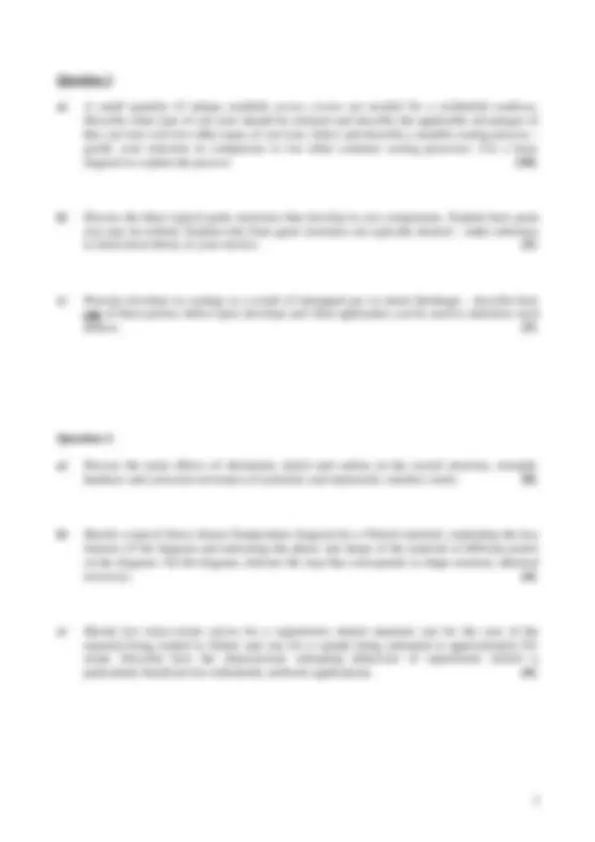



Study with the several resources on Docsity

Earn points by helping other students or get them with a premium plan


Prepare for your exams
Study with the several resources on Docsity

Earn points to download
Earn points by helping other students or get them with a premium plan
Community
Ask the community for help and clear up your study doubts
Discover the best universities in your country according to Docsity users
Free resources
Download our free guides on studying techniques, anxiety management strategies, and thesis advice from Docsity tutors
Information about the spring examinations for the mechanical and biomedical engineering departments in the academic year 2010/2011. Exam codes, module codes, instructions, and questions for the 3rd year mechanical engineering and biomedical engineering modules (me326: metals and metals processing). The questions cover topics such as crystallography, stress-strain behavior, and material properties. Students are required to answer multiple-choice questions and use schematics, graphs, and other materials. The exam duration is 2 hours, and the questions are released to the library after the exam.
Typology: Exams
1 / 3

This page cannot be seen from the preview
Don't miss anything!


Exam Code(s) 3BM, 3BG Exam(s) 3 rd^ Mechanical Engineering 3 rd^ Biomedical Engineering Module Code(s) ME Module(s) Metals and Metals Processing Paper No. 1 Repeat Paper External Examiner(s) Professor Noel O’Dowd Internal Examiner(s) Professor Sean Leen Dr Mark Bruzzi Dr Barry O’Brien Instructions: (^) Answer 3 questions
No. of Pages 3 Department(s) Mechanical & Biomedical Engineering Course Co-ordinator(s) Dr Mark Bruzzi Dr Barry O’Brien Requirements: MCQ Handout Statistical/ Log Tables Cambridge Tables Graph Paper Log Graph Paper Other Materials Release to Library: Yes
Question 1 a) Using Miller Indices, sketch a simple cubic structure and illustrate the [100], [010], [001] and [111] directions. Also illustrate a (111) plane. Sketch the crystallographic unit cells for Body Centred Cubic (BCC) and Face Centred Cubic (FCC) structures. What is the significance of a (111) plane in a FCC structure? [ 5 ] b) Draw a schematic engineering stress-strain curve for a material that exhibits both significant work-hardening and necking down before fracture. Clearly label the units for both stress and strain. Label the regions of elastic and plastic deformation. Indicate the yield strength, ultimate tensile strength, failure strength and strain at failure. Explain how the 0.2% proof stress is obtained and why it is often used. What feature on the graph quantifies the elasticity of the material? What term is generally used to describe this elastic property and present the simple relationship that defines it. [ 7 ] c) Explain the difference between Engineering Stress and True Stress and use schematic stress- strain curves to illustrate this. [4] d) A copper sample provides a yield strength of 100 MPa as it starts to plastically deform. However the sample is unloaded shortly after reaching yield strength and is tested again. Explain what you would expect to observe in relation to yield strength during this re-test: use dislocation theory to help your explanation. [4] Question 2 a) Sketch a typical Time-Temperature Transformation (TTT) curve for a 0.8% carbon steel, clearly indicating where austenite, pearlite, bainite and martensite are present. Illustrate what is the slowest cooling rate that can be used to obtain a full martensitic structure. Add in a line showing approximately 25% transformation and explain how this can be used to select a cooling rate to give a structure consisting of 25% pearlite and 75% martensite. [7] b) Briefly describe the crystal structure of martensite and how it is formed during quenching of steel. Use dislocation theory to explain how martensite provides strengthening/hardening. [5] c) Describe the process of tempering of steel, explaining the microstructural and mechanical property changes that occur. [ 3 ] d) Explain how the strength of aluminium alloy 2024 may be impaired during welding. [5]